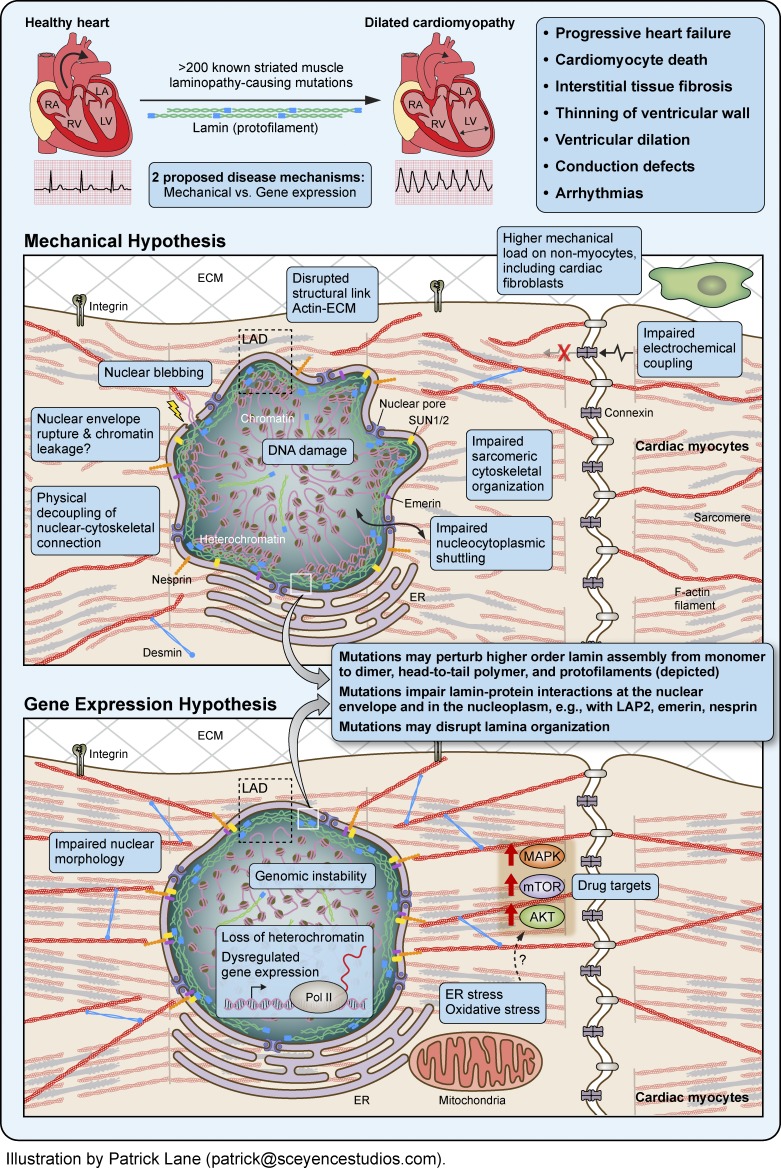Abstract
Miroshnikova, Hammesfahr, and Wickström illustrate the complex cell biological changes observed in cells of patients with Lamin A/C cardiomyopathies.
The mammalian genome encodes A-type lamins A and C (LMNA splice variants) expressed only in differentiated cells, and the ubiquitously expressed B-type lamins (1). Attributed to nearly half of the >600 described pathogenic LMNA mutations, striated muscle laminopathies are the most prevalent type of laminopathy. Life-limiting cardiac dysfunction is the unifying feature of these diseases that are caused by altered biophysical properties of muscle cells, resulting in thinning of ventricular walls, enlargement of ventricular volume, and impaired electrophysiological conduction. These defects compromise cardiac output and trigger malignant arrhythmias (2).
Lamins are the key component of the nuclear lamina separating the inner nuclear membrane from chromatin. Laminopathy-causing mutations are scattered along the LMNA gene. They may perturb lamin assembly to filaments and protofilaments or disrupt binding partner interactions, compromising lamin function and distribution. How exactly the various mutations in the LMNA gene disrupt the nuclear lamina and associated cellular functions to elicit the extremely heterogeneous pathological phenotypes with strikingly poor genotype-to-phenotype correlation remains a challenging open question. Two cardiomyopathy-driving mechanisms have been proposed: the mechanical and the gene expression models (2).
Despite expression in most differentiated cells, LMNA mutations have the most detrimental effects on the heart, a mechanically challenged tissue. In the mechanical model, loss of nuclear integrity impairs the ability of cells to cope with mechanical stress, leading to myocyte death, increased mechanical load on non-myocytes, and pathological heart remodeling. Additionally, the absence of lamin-mediated nuclear-cytoskeletal links abrogates mechanotransduction (3).
The gene expression model builds on lamins’ interactions with specific genomic loci, regulating their structure, epigenetic state, and transcriptional activity. Lamins interact with heterochromatin at regions termed lamina-associated domains (LADs) as well as in the nuclear interior, and impaired interactions alter chromatin architecture and positioning to disrupt gene regulation (4). Lamins have also been shown to modulate nuclear traffic, to interact with and regulate transcription factors and signaling molecules, and to regulate redox stress (5, 6).
Despite the separation of the two models, it is becoming clear that nuclear mechanotransduction is intimately linked to chromatin organization and gene expression control (3, 7). Many of the affected signaling pathways have been shown to be mechanosensitive, making the separation of the mechanical and gene expression models somewhat artificial.
While no curative treatment exists, interfering with the pathophysiological molecular effects of lamin mutants presents a promising target. The MAPK cascade (including p38α, JNK, and ERK 1/2) is abnormally activated in mutant cardiomyocytes. Inhibiting MAPK components or mTOR has been shown to improve the phenotype in mouse models of laminopathic cardiomyopathies, and clinical trials for a p38 inhibitor are ongoing (8).
Acknowledgments
Research in the Wickström laboratory is supported by Helsinki Institute of Life Science, Wihuri Research Institute, Max Planck Society, and the German Research Foundation Deutsche Forschungsgemeinschaft through SFB 829 A11. Y.A. Miroshnikova is supported by the European Molecular Biology Organization Long-Term Fellowship ALTF 728-2017.
The authors declare no competing financial interest.
References
- 1.de Leeuw R., et al. . 2018. Trends Cell Biol. 28:34–45. [DOI] [PubMed] [Google Scholar]
- 2.Gruenbaum Y., and Foisner R.. 2015. Annu. Rev. Biochem. 84:131–164. [DOI] [PubMed] [Google Scholar]
- 3.Kirby T.J., and Lammerding J.. 2018. Nat. Cell Biol. 20:373–381. [DOI] [PMC free article] [PubMed] [Google Scholar]
- 4.van Steensel B., and Belmont A.S.. 2017. Cell. 169:780–791. [DOI] [PMC free article] [PubMed] [Google Scholar]
- 5.Andrés V., and González J.M.. 2009. J. Cell Biol. 187:945–957. [DOI] [PMC free article] [PubMed] [Google Scholar]
- 6.Dialynas G., et al. . 2015. PLoS Genet. 11:e1005231. [DOI] [PMC free article] [PubMed] [Google Scholar]
- 7.Miroshnikova Y.A., et al. . 2017. J. Cell Sci. 130:2243–2250. [DOI] [PubMed] [Google Scholar]
- 8.Bonne G., and Muchir A. Cardiomyopathy Caused by Mutations in Nuclear A-Type Lamin Gene. 2017. [DOI] [Google Scholar]



